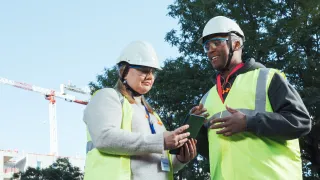More dynamic office and remote work through sitting and standing – SitFit

Objectives
The number of employees who perform their work tasks sitting down is increasing on a global scale. On average, working age people spend 30–50 per cent of their working hours seated. On an average work day, a person normally sits for a hundred minutes more than on a day off. Office workers sit for 66 per cent of their working hours. The restrictions brought on by the COVID-19 pandemic have increased remote work.
The first studies on the subject indicate that remote work reduces activity and increases the amount of sitting during a working day. A wide variety of models and instructions for taking breaks while sitting have been provided based on the research. That said, measurement data on the physiological and cognitive impacts of breaks during sedentary work is required for developing, clarifying and harmonizing the instructions.
The aim of this project is to determine what types of breaks are most efficient in minimizing the harmful effects of sedentary work. The study will examine the ways in which office work that is exclusively sedentary does not sufficiently strain the musculature and the respiratory and circulatory systems. Further targets of the study are models for breaking up periods of sitting that yield the optimal physiological and cognitive responses.
Based on the results, clear recommendations on taking breaks during sedentary work, based on research, will be provided.
Data and methods
The research will be initially conducted in a laboratory, where the optimal model for breaking up types and periods of sitting will be determined. The suitability of the model for practical working life will be determined through a field study.
Results and impact
Finland has a high number of knowledge workers and they mostly spend their working hours sitting down. The structure related to professions and sectors, good data connections and the prevalence of digital devices also facilitate widespread remote work. Reducing the detrimental effects of the large amount of time Finnish workers spend sitting down is an important factor in terms of promoting occupational and general health. The main ways of reducing the detrimental health effects of sedentary work are taking breaks in and reducing the total time spent sitting down. For this reason, spending less time sitting and being passive is also important for those who engage in physical activity in their free time.
The research-based recommendations and instructions on reducing sedentary hours are inconsistent. This study combines standardized laboratory research and field research. In the laboratory, physiological and cognitive measurements will be used to determine the optimal frequency and method of breaking up periods of sitting. The field research will assess the results of the laboratory research in authentic office work conditions. The results will be used to prepare clear, research-based recommendations on the best way to minimize the insufficient physical load caused by sedentary office work.
Our experts

Satu Mänttäri
Research group
Juha Oksa, chief researcher
Pihla Säynäjäkangas, researcher
Jutta Karkulehto, researcher
Ari-Pekka Rauttola, senior specialist
Kristian Lukander, senior specialist
Teemu Paajanen, senior psychologist
Partners
The partner for the project is Helsingin yliopiston kiinteistöpalvelut Oy (HY247).
Funding
This project is funded by The Finnish Work Environment Fund, Helsingin yliopiston kiinteistöpalvelut Oy





